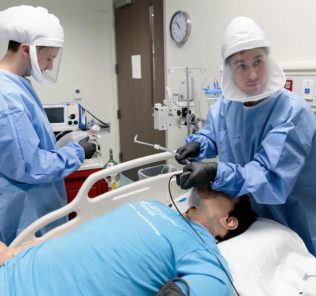Actors Play Patients to Train Medical Students for Real-Life Work
More great simulation news from Singapore this week, with an article highlighting the use of Standardized Patients to help medical students learn. Read last week’s article about the new partnership between SingHealth and the SCDF for paramedic simulation training.
Excerpt from StraitTimes:
Medical schools are turning to part-time actors to help students polish their bedside manners, long before they reach a real patient’s bedside. The actors take part in elaborate role plays, simulating patients to help mimic the challenges of hospital work. This could mean playing a distraught family member, a patient who cannot speak English or a senior doctor.
Sponsored Content:
“I’m driven very much by the fact that it gives me a chance to help put the doctors’ hearts into medicine,” said Mr Davin Boo, who used to be a bit-part actor and is now self- employed.
The 48-year-old has been part of the National University of Singapore (NUS) Yong Loo Lin School of Medicine’s programme for the past three years.
Even with acting experience, he said that working as a simulated patient can be challenging as it requires improvisation. I’ve been lectured by doctors or felt judged, or just treated as a figure in a ward. It’s wonderfully satisfying to be able to help change that. DAPHNE ONG, a professional actress, on what she hopes to achieve by working as a simulated patient. “As an actor, you just go by the script,” he said. “As an actor, you just go by the script,” he said. “As a simulated patient, you may be able to pre- empt responses, but it’s not a fixed script on the other end.”
Retired teacher Eugene Eu, 58, said that he likes the ability to interact with young people and – a personal bonus – understand what his daughter has to deal with. “My daughter has just started doing her nursing diploma and, with this experience that I have, I’m able to empathise with her,” he said. “We have this thing in common.”
Sponsored Content:
NUS has around 160 such actors, while the new Lee Kong Chian School of Medicine at Nanyang Technological University (NTU) has around 100. Associate Professor May Lim, who is programme director for occupational therapy at SIT, said: “We decided it’s very important for students to learn from the people they will be treating, through interaction in the community and beyond a clinical setting.”
Read the full article: Actors play patients to train medical students for real-life work
Lance Baily, BA, EMT-B, is the Founder / CEO of HealthySimulation.com, which he started in 2010 while serving as the Director of the Nevada System of Higher Education’s Clinical Simulation Center of Las Vegas. Lance also founded SimGHOSTS.org, the world’s only non-profit organization dedicated to supporting professionals operating healthcare simulation technologies. His co-edited Book: “Comprehensive Healthcare Simulation: Operations, Technology, and Innovative Practice” is cited as a key source for professional certification in the industry. Lance’s background also includes serving as a Simulation Technology Specialist for the LA Community College District, EMS fire fighting, Hollywood movie production, rescue diving, and global travel. He and his wife live with their two brilliant daughters and one crazy dachshund in Las Vegas, Nevada.
Sponsored Content:


















